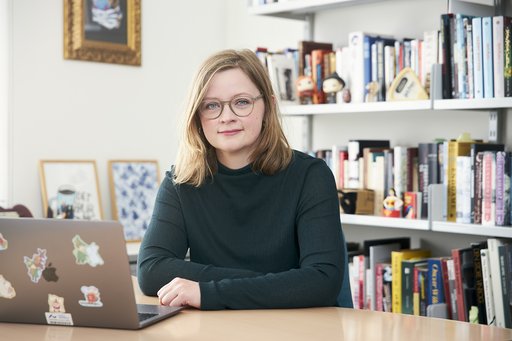Sarah Mygind

The Media Has an Impact on the Way We Read
Transmedia CHILDREN’S LITERATURE
Sarah Mygind has contributed substantive theory and concept formation about the importance of digitalisation for literature and reading.
By Filip Graugaard Esmarch
The concept of ‘cluster works’ has the potential to gain general acceptance within literature research. Until now, a word has been missing to describe a rather fundamental phenomenon, i.e. that a children's literary narrative is published in multiple media at the same time, such as a paperback, e-book, audiobook and perhaps with associated fiction universes with animated films, apps or computer games. The creator of the concept, PhD Sarah Mygind, explains it this way:
‘Most often, it is clear that some thought has been given to what the individual media is able to do. You often conceive of your narratives across media right from the beginning. And while, on the surface, it may be the same narrative, each version will contribute significantly to the overall picture. For a literary researcher, this also means that a narrow view of literature linked exclusively to the printed book will be distinctly inadequate’.
At the AU centres Literature Between Media and Children’s Literature and Media, Sarah Mygind has explored how children’s and youth literature transcends traditional media boundaries, but also how the complexity of literature caused by digitisation has affected the recipients.
The Media Shapes the Text
According to Sarah Mygind, the lack of theory and concepts in the field is caused by the fact that literature as media-borne has been overlooked in literature research:
‘Focus has been on the content of the books. The question of how literature is borne by the media has more or less been limited to book history studies of e.g. special editions of classical works. However, we have now begun to study what it means that books have become digital, and how the media shapes the text’.
Sarah Mygind has analysed and interpreted specific cluster works in her thesis, but at the same time she has included literature sociology and linked it to a more media-scientific approach.
‘I would like to know the aim of the texts, how they are made, and how they are received. So, I am interested in some interaction between the work-internal and the work-external. Therefore, it has been a matter of getting the disciplines to communicate in a meaningful way’, she explains.
Nuances to the Debate
A main point is that the various digital formats help shape the way we read. At the same time, Sarah Mygind believes her research can help bring nuances to the public debate which is characterised by a hierarchical approach to reading and literature.
‘Media contribute in different ways with something unique to the literary experience. However, when it is argued that children do not read as much as they used to, the media in mind is typically novels. If children instead prefer computer games, they may in fact be doing a lot of reading, because texts are also vital in the virtual, interactive universes. It is just a different form of reading’, Sarah Mygind points out.
After completing her PhD, she did a postdoc and how holds a position as assistant professor in children’s literature and comparative literature at AU. Here she has researched how children read in various media, and she plans to increase her focus on the production aspect.